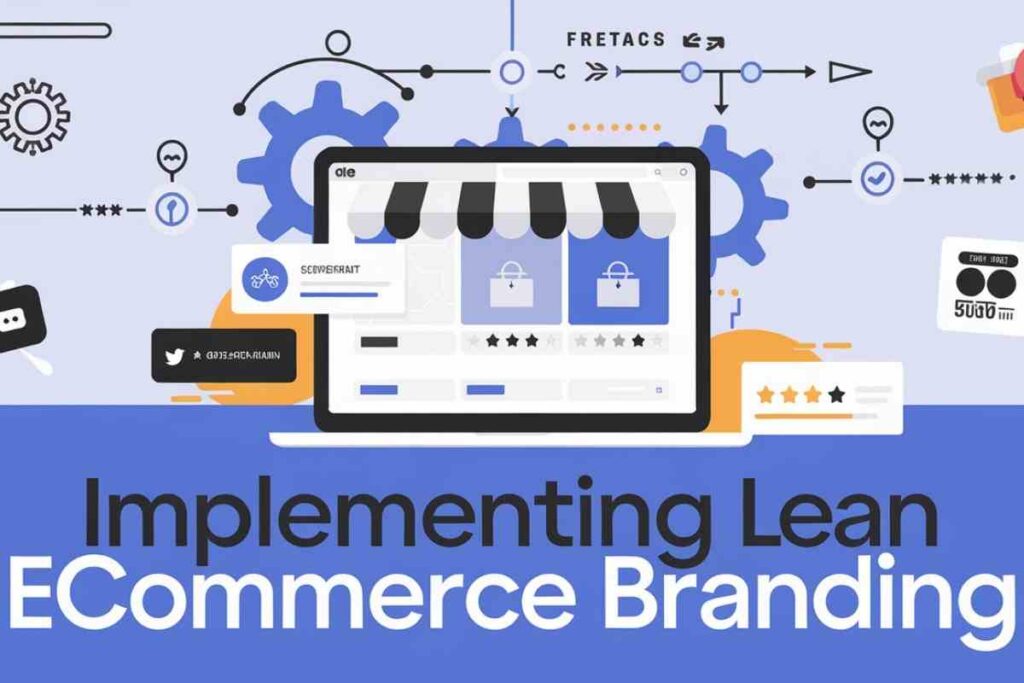Branding plays a pivotal role in the success of eCommerce ventures. It goes beyond logos and slogans, serving as the lifeblood that distinguishes businesses in the digital marketplace.
In today’s competitive landscape, where consumer choices abound, effective branding guides customers through the clutter to your digital storefront. A strong brand fosters trust, cultivates customer loyalty, and significantly impacts sales and growth.
In this article, we explore the essential role of branding in the success of eCommerce ventures, emphasizing the significance of adopting a lean approach. We will delve into the concept of lean eCommerce branding, outlining its key characteristics, benefits, and strategies for implementation.
Understanding Lean Ecommerce Branding
A lean eCommerce brand embodies a streamlined approach to branding that focuses on creating a unique identity and value proposition for online businesses. This concept emphasizes efficiency and effectiveness in branding strategies to stand out amidst the vast online competition.
Key Characteristics of Lean Ecommerce Branding
- Efficiency: Prioritizing cost-effective strategies that deliver results.
- Agility: Being adaptable to market changes and customer needs.
- Customer-Centricity: Tailoring branding efforts to resonate with the target audience.
- Innovation: Embracing creativity and uniqueness to stand out in a competitive landscape.
Benefits of Adopting a Lean Approach in Ecommerce Branding

- Cost-Effectiveness: Lean strategies help businesses achieve branding goals without excessive spending.
- Flexibility: Being nimble allows quick adjustments to meet evolving market demands.
- Competitive Edge: By focusing on differentiation, lean brands can carve a niche in saturated markets.
- Customer Loyalty: Tailored branding efforts foster strong connections with customers.
- Efficiency: Streamlined processes lead to optimized resource utilization and improved outcomes.
Examples of Successful Lean Ecommerce Brands
- Warby Parker: Known for its direct-to-consumer model and affordable, stylish eyewear.
- Everlane: Emphasizes transparency in pricing and sourcing, appealing to conscious consumers.
- Allbirds: Focuses on sustainable materials and minimalist design, resonating with eco-conscious shoppers.
- Casper: Disrupted the mattress industry with innovative marketing and a customer-centric approach.
These brands exemplify the essence of lean eCommerce branding by effectively combining efficiency, innovation, and customer-centric strategies to achieve success in the digital marketplace.
Key Elements of Lean Ecommerce Branding
Several key elements shape a successful brand identity and resonate with customers effectively:
- Identifying Your Target Audience and Niche:
- Understanding your target audience’s demographics, preferences, and behaviors is essential for tailoring your branding efforts.
- Identifying a niche market allows you to focus your branding strategies on a specific segment, making your brand more relevant and appealing.
- Crafting a Compelling Brand Story and Message:
- Developing a brand story that connects with customers emotionally can set your brand apart.
- A compelling brand message communicates your values, mission, and unique selling proposition, creating a strong bond with your audience.
- Creating a Strong Visual Identity and Brand Voice:
- Establishing a visually appealing brand identity through logos, colors, and design elements helps create instant recognition.
- Defining a consistent brand voice that reflects your brand’s personality and values enhances customer engagement and loyalty.
- Building Brand Consistency Across All Touchpoints:
- Ensuring consistency in branding elements across all customer touchpoints—including website, social media, packaging, and emails—reinforces brand recognition.
- Consistency builds trust and familiarity, making your brand memorable and reliable in customers’ eyes.
Strategies for Success

Implementing specific strategies is crucial for achieving success in lean eCommerce branding:
- Leveraging Social Media for Brand Building:
- Social media plays a pivotal role in brand building for eCommerce businesses. It offers a platform to engage with customers, build brand awareness, and drive sales.
- Utilizing social media for advertising, customer support, and audience engagement can significantly enhance brand visibility and loyalty.
- Implementing Influencer Marketing Tactics:
- Collaborating with influencers who resonate with your target audience can amplify your brand’s reach and credibility.
- Authentic influencer partnerships can help build trust, drive engagement, and increase brand awareness among potential customers.
- Optimizing User Experience for Brand Loyalty:
- Providing a seamless and enjoyable user experience on your eCommerce platform is essential for fostering brand loyalty.
- Easy navigation, personalized recommendations, responsive customer service, and hassle-free transactions create a positive user experience that keeps customers returning.
- Utilizing Data Analytics for Informed Branding Decisions:
- Leveraging data analytics tools can help eCommerce brands make informed decisions regarding branding strategies.
- Analyzing customer behavior, preferences, and trends allows businesses to tailor their branding efforts, optimize marketing campaigns, and enhance the overall customer experience.
Case Studies
Calvin Klein Australia
- Objective: Achieve a 142% increase in organic revenue.
- Strategy: Implemented a full-service SEO campaign to improve organic visibility.
- Outcome: Increased Domain Authority from 9 to 52, leading to enhanced search visibility and significant revenue growth.
Ultraceuticals
- Objective: Increase conversions by 330%.
- Strategy: Focused on optimizing pages for high-converting keywords.
- Outcome: Saw a substantial increase in conversions and organic search revenue.
The Iconic
- Strategy: Utilized data analytics for personalized recommendations and tailored merchandising.
- Outcome: Leveraged data insights to forecast demand, optimize merchandising, and enhance customer experience.
These case studies exemplify how lean eCommerce brands like Calvin Klein Australia, Ultraceuticals, and The Iconic have leveraged strategic SEO, data analytics, and personalized approaches to achieve significant growth and enhance customer engagement in the competitive digital landscape.
Implementing Lean Ecommerce Branding

- Conduct Market Research and Niche Selection:
- Identify profitable and underserved niches through market analysis.
- Use tools like Google Analytics and social media insights to understand customer behavior.
- Develop a Minimum Viable Product (MVP):
- Create a basic version of your product to gather customer feedback.
- Iterate on the product based on real user responses to enhance its appeal.
- Streamline Operations:
- Optimize business processes to reduce waste and increase efficiency.
- Automate repetitive tasks to save time and resources.
- Emphasize Customer Feedback:
- Regularly solicit and analyze customer feedback for continuous improvement.
- Use surveys, reviews, and social listening to understand customer needs and preferences.
- Build a Compelling Brand Identity:
- Create a strong visual identity (logo, color scheme) that resonates with your target audience.
- Develop a consistent brand voice and messaging that reflects your values.
- Maintain Brand Consistency Across Channels:
- Ensure uniformity in branding elements across all touchpoints (website, social media, packaging).
- Reinforce brand recognition through consistent messaging and visuals.
- Leverage Social Media for Engagement:
- Utilize social platforms to connect with customers, build brand awareness, and drive traffic.
- Engage with your audience through interactive content, polls, and user-generated content.
- Implement Influencer Marketing:
- Collaborate with relevant influencers to extend brand reach and credibility.
- Choose influencers who align with your brand values and resonate with your target market.
- Optimize User Experience (UX):
- Create a seamless and enjoyable shopping experience on your website.
- Focus on easy navigation, personalized recommendations, and responsive customer service.
- Utilize Data Analytics:
- Leverage analytics tools to monitor customer behavior and track key performance indicators (KPIs).
- Use insights to make informed decisions about branding strategies and marketing campaigns.
- Measure and Evaluate Branding Success:
- Regularly assess branding effectiveness through customer engagement metrics, conversion rates, and brand awareness.
- Adapt strategies based on performance data and customer insights to enhance branding efforts continuously.
Current Trends in Lean Ecommerce Branding
Staying updated with the latest trends is crucial in the evolving eCommerce landscape:
- Sustainability: Consumers are increasingly drawn to brands that prioritize environmental responsibility.
- Personalization: Tailoring marketing messages and product recommendations to individual preferences is becoming standard.
- Omnichannel Experiences: Brands are integrating online and offline experiences to create seamless customer journeys.
Common Pitfalls to Avoid
When implementing lean eCommerce branding, be mindful of these common mistakes:
- Neglecting Customer Feedback: Ignoring insights from customers can lead to missed opportunities for improvement.
- Inconsistent Branding: Inconsistency in branding elements can confuse customers and erode trust.
- Overcomplicating Processes: Streamlining operations is essential; complexity can lead to inefficiency.
Conclusion
In conclusion, lean eCommerce branding empowers businesses to succeed by focusing on efficiency, customer-centric strategies, and continuous improvement.
By embracing a lean approach, companies can streamline operations, enhance customer experiences, and drive sustainable growth in the competitive digital landscape.
To excel in lean eCommerce branding, it’s vital to engage in continuous learning, adapt strategies based on real-time data and customer feedback, and remain agile in the face of market changes.
For those looking to pave the way for long-term success in the online marketplace, implementing these strategies can be the key to resilience and growth.
FAQS
What is lean eCommerce branding?
Lean eCommerce branding is a streamlined approach that focuses on creating a unique identity and value proposition for online businesses while emphasizing efficiency and cost-effectiveness in branding strategies.
Why is branding important for eCommerce businesses?
Branding is crucial for eCommerce as it helps distinguish businesses in a crowded marketplace, fosters customer trust, builds loyalty, and significantly impacts sales and growth.
How can I identify my target audience for lean branding?
You can identify your target audience by analyzing demographics, preferences, and behaviors through market research, customer surveys, and social media insights.
What are the key elements of successful lean eCommerce branding?
Key elements include defining your target audience, crafting a compelling brand story, creating a strong visual identity, and maintaining brand consistency across all touchpoints.
How do social media and influencer marketing impact eCommerce branding?
Social media enhances brand visibility and customer engagement, while influencer marketing can amplify your brand’s reach and credibility by connecting with relevant audiences.
What role does data analytics play in lean eCommerce branding?
Data analytics helps businesses make informed branding decisions by analyzing customer behavior and preferences, optimizing marketing campaigns, and enhancing the overall customer experience.
How can I ensure consistency in my branding across different channels?
To maintain consistency, ensure that all branding elements, including logos, color schemes, messaging, and visuals, are uniform across your website, social media, and packaging.
What are some common pitfalls to avoid in lean eCommerce branding?
Common pitfalls include neglecting customer feedback, inconsistent branding elements, overcomplicating processes, and failing to adapt to market changes.




